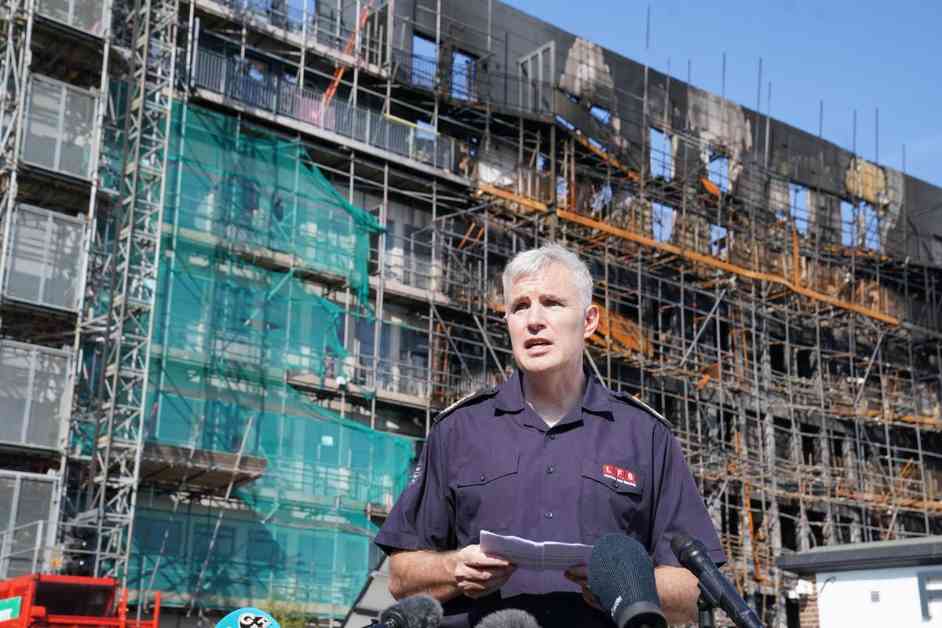Improving Building Regulations Post-Grenfell Tragedy
In the wake of the devastating Grenfell Tower fire in 2017, efforts have been made to strengthen building regulations to enhance fire safety in high-rise buildings. However, according to London Fire Brigade (LFB) commissioner Andy Roe, these regulations are still lacking in key areas. Speaking at a City Hall meeting, Mr. Roe expressed his concerns that while some important changes have been implemented, there is still a need for more stringent enforcement and better coordination among authorities.
Mr. Roe highlighted a specific case in Dagenham, where a seven-floor building was in the process of removing its cladding before a fire broke out. Despite the fire service being aware of the building’s details, including the managing agent and owner, a catastrophic fire still occurred. This incident serves as a stark reminder that the current regulations governing high-rise buildings are not functioning as effectively as they should be.
Challenges in Enforcing Regulations
One of the key issues identified by Mr. Roe is the lack of “teeth” in the enforcement of building regulations. While various bodies, including the building safety regulator, local authorities, and the Secretary of State, have powers to oversee compliance, there is a need for greater alignment and collaboration among these entities. Without a unified approach to enforcing regulations, there is a risk that gaps in oversight could lead to tragic incidents like the Grenfell Tower fire.
Furthermore, Mr. Roe acknowledged the challenges faced by the London Fire Brigade in responding to major incidents, such as the Grenfell fire. The volume of calls received during such emergencies can overwhelm control rooms, highlighting the need for improved systems and resources to handle large-scale emergencies effectively. Despite the commendable efforts of control staff during recent incidents, including the July 2022 wildfires, there is a recognition that more work needs to be done to ensure preparedness for future emergencies.
Addressing the Gaps in Building Safety
In response to the ongoing concerns raised by Mr. Roe and other experts in the field, there have been calls for a comprehensive review of building regulations and fire safety standards. This review would aim to identify gaps in the current system and propose measures to strengthen enforcement, improve coordination among authorities, and enhance overall building safety.
One potential solution proposed is the establishment of a centralized database that consolidates information on high-rise buildings, including details on construction materials, maintenance records, and ownership. By having a comprehensive database accessible to relevant authorities, it would be easier to monitor compliance with regulations, track building safety standards, and address potential risks proactively.
Additionally, there have been discussions about the need for regular inspections and audits of high-rise buildings to ensure compliance with fire safety regulations. By conducting thorough assessments of building structures, cladding materials, and fire prevention measures, authorities can identify potential hazards and take corrective actions to mitigate risks before they escalate into emergencies.
Collaborative Efforts for Safer Buildings
Building safety is a shared responsibility that requires collaboration among various stakeholders, including building owners, developers, regulators, and emergency services. By working together to identify risks, implement preventive measures, and respond effectively to emergencies, we can create safer environments for residents and occupants of high-rise buildings.
One approach to fostering collaboration is through the establishment of multi-agency task forces that bring together experts from different fields to address complex issues related to building safety. These task forces could facilitate information sharing, joint inspections, and coordinated response efforts to ensure that high-rise buildings meet the highest standards of fire safety and compliance.
Moreover, community engagement plays a crucial role in building a culture of safety and resilience in high-rise buildings. By involving residents in fire safety training, emergency preparedness drills, and risk assessment activities, we can empower individuals to take proactive measures to protect themselves and their communities in the event of a fire or other emergencies.
In conclusion, the tragic events of the Grenfell Tower fire have underscored the urgent need for stronger building regulations, enhanced enforcement mechanisms, and greater collaboration among authorities to ensure the safety of high-rise buildings. By addressing the gaps in the current system, implementing proactive measures, and fostering a culture of safety, we can prevent future tragedies and create safer environments for all.












